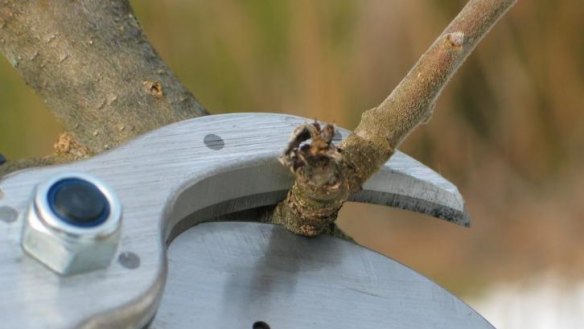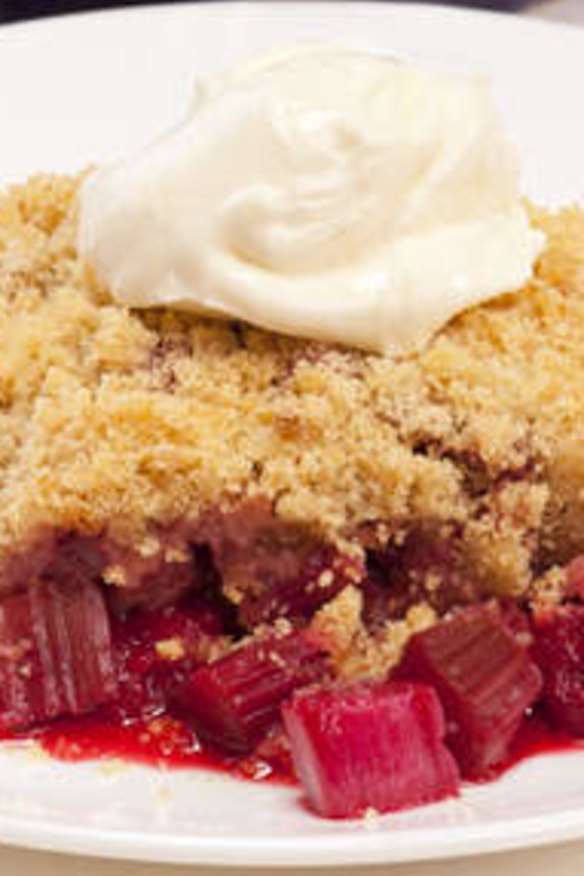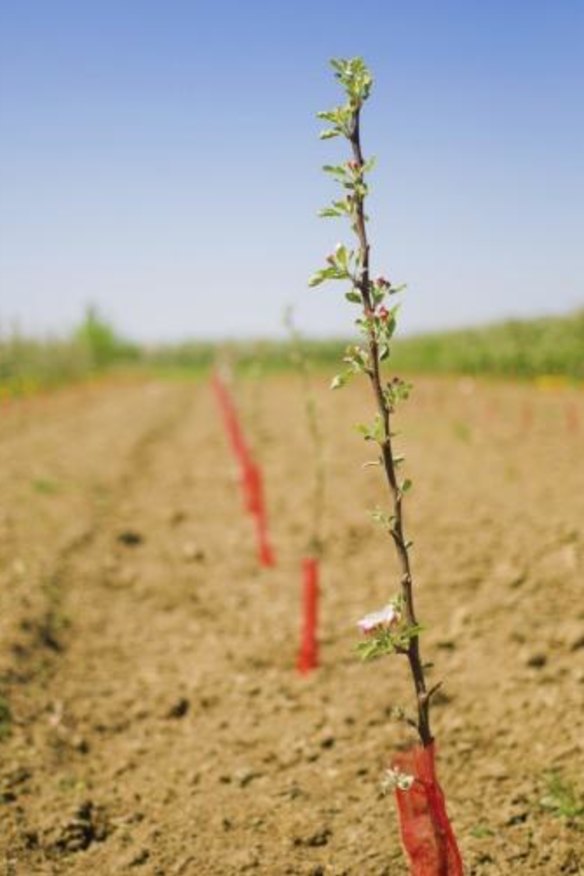Planting fruit trees in Canberra region

As winter approaches, our thoughts in the garden are turning now to reshaping, replanting and perhaps expansion.
The landscape is critical to the success of any planting of fruit trees. You really need to get things right now, before planting takes place. For the Canberra region, the most common problem is poor drainage but sometimes the opposite situation can give you as much trouble.
Most types of fruit trees will not grow well with ‘wet feet’. They need good drainage. So if you have the typical clay based subsoil then you will need to dig out a quantity of subsoil and replace with a quantity of small rubble and top soil, to ensure drainage This is particularly important if you wish to plant cherries, peaches and nectarines, apricots and apples. Pears and quinces can manage the best with heavy, poorly drained soil.

Adequate access to sunlight is also important. Many suburban gardens have beautiful eucalypt trees growing along their borders. The root systems are aggressive and the spreading branches block much needed sunshine. So if you are setting up your backyard garden, do check on the final size and height of any eucalypt trees that you are considering planting. Smaller Australian natives can be trimmed back more easily to avoid the problems of too much shade.
Another important aspect with fruit trees is the matter of cross pollination. There are few varieties that are truly self fertile, so if you want to produce a bountiful harvest of a selected fruit you need to consider if you have the space for two or three trees that will cross pollinate each other – whose blossoms open at the same time.
Varieties of any fruit will vary in size quite dramatically. As well, there is a big colour, flavour and texture range for apples. Pears come in many shapes and sizes from the small Corella to the large Howell and Beurre Bosc. Of course the final size of any fruit will also depend greatly on the growing conditions of the season and the volume of other fruit left on the tree.

There can be quite distinctive characteristics of cultivars from specific countries. English folk seek out their famous Cox’s Orange Pippin with its distinctive rich flavour. The French love their Reinette apples with such motley skins but firm and rich tasting flesh inside.
Then you have the question of uses. What do you want to do with your fruit – a very important question for plums and apples. If you want to eat fresh fruit you will choose different varieties than if you mostly want to cook, preserve and bottle.
As well, your preferred timing of your harvest season will influence your choices. Remember that, in general, the early maturing varieties do not keep as well as those that take longer to ripen; the shorter the growing season, the shorter the storage time.
As most fruit trees are harvested over just one or two weeks, the way to extend the fruit eating season is to select and plant out more than one variety that will mature over an extended period. There are apple varieties that can be picked from early January through to the very late season Lady William that does not mature until late June (one parent apple of the Pink Lady).
Where you have space limitations, you can plant fruit trees that have been grafted onto dwarf rootstock, so that the height of the trees will never reach more than 2 metres. And you can consider buying double-grafted trees to get your necessary cross pollination on just one tree. As well, you can plant many fruit trees along your back fence, as espaliered trees, so that they grow quite flat against the wall/fence and so do not take up much of the available space. You may harvest smaller quantities of fruit from each tree but the volume will still be sufficient for most families.
Stone fruit have a shorter winter break, which is why I have encouraged you to prune early. In the same way, it is best to get your stone fruit planted out in June or July so that they are well bedded-in before they begin to flower in late August or early September.
Moor and Trevatt are two reliable apricots. Moorpark originated in England back in 1668 and produces large fruit of excellent flavour. Trevatt is best left to fully mature on the tree (you will need to net apricot trees in Canberra, along with any cherry trees. Rival is a newer variety from Canada, with a very dark orange skin. The fruit is large, sweet and rich.
Santa Rosa and Mariposa are two good dark flesh plum varieties. Coe’s Golden Drop and Green Gage are two lovely yellow-flesh plums.
Bing and Van are two good, mid season cherries producing larger sized fruits and they can cross pollinate. Stella is a good mid season self-pollinating cherry, from Canada. Stella will pollinate the lovely dark Merchant cherry which ripens two weeks earlier than Bing. Lapins is a good late season cherry, also from Canada. It is also self-fertile but can serve to pollinate several other varieties of cherries.
There are many peach and nectarine trees available. I like the older peach varieties including Elberta and O’Henry which produce delicious rich-tasting fruit. Many of the newer varieties have been brought in from a breeding program in California. Local nurseries will have a good range of freestone and clingstone trees over the winter months. Aim to buy trees that have not had their root systems cut back severely just to make them fit onto a small plastic garden pot – this practice by some nurseries sets the tree back two years.
A very good range of fruit trees, both modern and heritage, are offered by a small number of specialist nurseries in Victoria and Tasmania. They have grafted most varieties onto dwarf or semi dwarf rootstocks that are very suitable for backyard gardens. Yalca Fruit Trees and Heritage Fruit Trees are both based in Victoria. Woodbridge Fruit Trees are in Tasmania. They all have very well-designed websites with photos and descriptions of each available variety.
Next week: A detailed discussion on apple, pear and quince varieties.
Rhubarb and apple crumble
500 gm rhubarb
4 large Granny Smith apples
½ tsp cinnamon
¾ cup sugar
juice of ½ lemon
Crumble Topping
1½ cups plain flour
¼ cup coconut
½ cup brown sugar
100 gms butter
¼ cup chopped walnuts
Peel, core and slice the apples. Trim off the leaves of the rhubarb and chop the stems into 3cm-long pieces. Preheat the oven to 180°C. Place the apples, cinnamon, sugar and lemon juice in a saucepan and cook at moderate heat for 3 to 4 minutes, stirring regularly. Add in the rhubarb pieces and cook for a further 5 minutes, until the rhubarb and apple pieces are tender. Spread the cooked fruit across the base of an ovenproof dish.
Take a separate bowl and combine the flour, coconut and brown sugar. Rub in the butter with your thumbs and forefingers until the mixture resembles breadcrumbs. Sprinkle the topping over the fruit base and then scatter the walnut pieces across the top. Bake for 30 minutes until the topping is golden brown.
From Owen Pidgeon's Loriendale Fruits of the Orchard Cookbook.
This week in the garden
• Sow shallots and leek seeds into a propagation tray, and place in a warm, protected sunny spot to ensure good germination.
• Aim to keep up the weeding and mulching of your garlic, peas and broad beans patches. If you have space plant more rows of peas for a delightful Spring treat.
• Prepare a deep, rich bed to plant your rhubarb sets and asparagus in the coming month. If you have well established rhubarb plants, check to see if they are big enough to divide.
• Begin pruning back your berry plants. With brambleberries, remove completely all the second year brambles that produced berries this past summer, then tie up the new season's canes to your trellis wires. They can be quite long, so loosely wrap small bundles of canes along the horizontal wires.
• Sharpen your secateurs for the winter pruning work. If they are too old, treat yourself to a good quality new pair, such as the Swiss Felco brand as this tool is your companion for three months of each year.
• If you are considering planting out replacement strawberry plants, now is the time to prepare the hilled-up rows in the garden. Add generous quantities of compost as a well developed, deep root system is vital for good production.
Owen Pidgeon runs the Loriendale Organic Orchard near Hall.
Restaurant reviews, news and the hottest openings served to your inbox.
Sign up